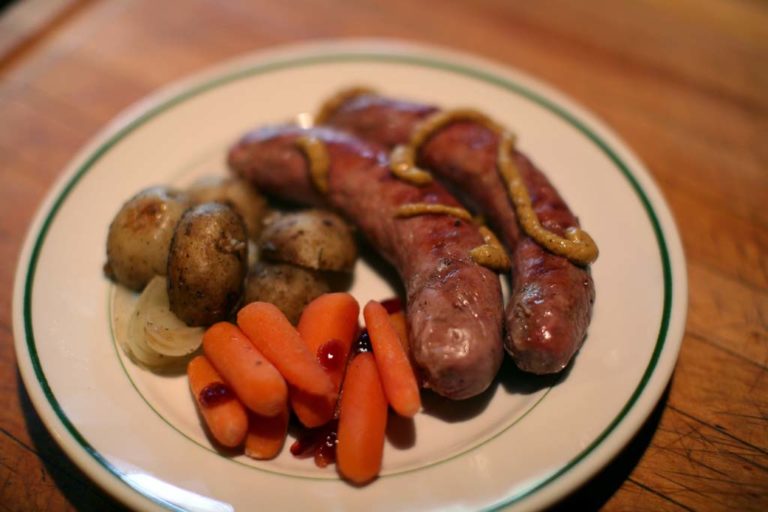
Chef's notes:
I don’t think that the Germans invented sausage, even though the word sausage or, more specifically, “wurst” definitely conjures images of short fat dudes in lederhosen drinking from enormous mugs of beer.
The correct German word for sausage is würst. As in bratwürst, knackwürst, bockwürst, leberwürst, and currywürst. This brings us back to our topic of grilling bratwurst. I am talking about the American version of bratwurst; you may have noticed that I have dropped the umlauts. The bratwurst in America were brought over by immigrants a long time ago. And like any food separated from its homeland, it will adapt to accommodate its new surroundings. The end result being a wide variety of different bratwurst. Not such a bad thing. The classic bratwurst even survived in some form. The classic or traditional brat is my favorite. What’s your favorite?
Ingredients
- 4 bratwurst
Pork Bratwurst Grilled on a Gas Grill and Served with a Nice Spicy German Mustard
- Select a bratwurst to grill. I may have said above that my favorite bratwurst are the classic ones, but that doesn’t mean I don’t like to try the other ones. The bratwurst in the picture to the right are garlic brats from a small butcher shop just over across the border in Wisconsin. And Wisconsin, as you should know, makes good bratwurst. For this article I am using a gas grill. Even though I prefer charcoal, the gas grill was what was available at the time.
- Let the grill heat up for a few minutes before putting the brats on. One important thing to remember about grilling is to let the grill heat up for a few minutes before putting any meat on it. Light the grill and crank it up to maximum heat. Then close the lid and let it heat for 5‒7 minutes. You may also want to brush the grates with a little vegetable oil after you have cleaned them off, of course. Place the brats directly over the heat and watch them cook for a few minutes.
- Flip the brats to grill the other side. After about 5‒6 minutes, check the brats to see if they are getting dark on the bottom. There should be dark brown grill marks and some other browned areas. Flip them over and continue grilling. If you think the grill is too hot, turn it down a little. But my experience has been that most gas grills are rarely too hot. In fact, they are usually much too wimpy, which is why I prefer charcoal.
- Check the internal temperature of the grilled brats to make sure they are done. After a few more minutes on the other side, the brat may be done. You can try squeezing it to check for doneness, but the best way to know for sure is to stick it with a thermometer. Slide it in the tip of the brat, pushing the probe towards the brat’s center. The thermometer should read at least 160 degrees F. Be careful when pulling the thermometer out or you may get a geyser of pork fat in your face.
Tips & Tricks
- While bratwurst are on the grill, they can be quite dangerous—at any moment a geyser of scalding hot pork fat may erupt. This may occur towards the end of cooking, and almost always these geysers are a signal that the brats are done, or more likely over-done.
- Use a set of spring-loaded tongs to flip and rotate the bratwurst. You don’t want to pierce the casing while it’s cooking. This will cause the brat to dry out.
- Bratwurst need a few minutes to rest before they can be eaten. Otherwise someone will get burned with molten fat.
- Gas grills can be made hotter. Do this by removing the tin flashing or guard that covers the flame. It’s usually triangular shaped, and it just lifts off. The direct heat of the flames will help to caramelize the outside of the meat.
- Make sure you clean the grill every time you use it, especially the grates—you know, the part the food touches.
- By the by, in Germany a mug of beer is called a bierkrug, not a stein. Stein came from the German word steingut, which means stoneware, the once preferred mug-making material before glass became popular. In fact, in German the word bierstein refers to a crusty, old, oft used but ne’er-been washed beer mug. Also, while we are on the topic, the German word wiener does not mean what it means here. In German, a Wiener is someone from the large, historic, and beautiful city of Wien, a.k.a. Vienna.
Additional Toppings
Mustard, Onion, Relish, Cheese, Pickles, Chili, Beans, Salsa, Peppers, Chips, Ketchup, Mayo, Brown mustard, Hot mustard, Sweet mustard
